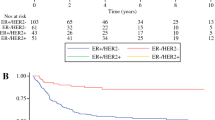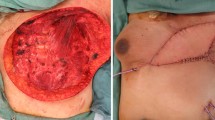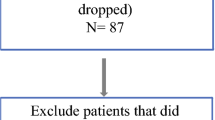Abstract
Background
Inflammatory breast cancer (IBC) is a rare and aggressive subtype. This study analyzes the patterns of failure in patients with IBC treated at our institution.
Methods
We retrospectively analyzed the records of 227 women with IBC presenting between 1997 and 2011. Survival analysis was used to calculate overall survival (OS) and disease-free survival. Competing risk analysis was used to calculate locoregional recurrence (LRR).
Results
A total of 173 patients had locoregional-only disease at presentation (non-MET). Median follow-up in the surviving patients was 3.3 years. Overall, 132 (76.3 %) patients received trimodality therapy with chemotherapy, surgery, and radiotherapy. Three-year OS was 73.1 % [95 % confidence interval (CI) 64.9–82.4]. Cumulative LRR was 10.1, 16.9, and 21.3 % at 1, 2, and 3 years, respectively. No variable was significantly associated with LRR. Fifty-four patients had metastatic disease at presentation (MET). Median follow-up in the surviving patients was 2.6 years. Three-year OS was 44.3 % (95 % CI 31.4–62.5). Twenty-four (44.4 %) patients received non-palliative local therapy (radiotherapy and/or surgery). For these patients, median OS after local therapy was 2 years. Excluding six patients who received local therapy for symptom palliation, the crude incidence of locoregional progression or recurrence (LRPR) was 17 % (4/24) for those who received local therapy compared with 57 % (13/23) for those who did not.
Conclusions
For non-MET patients, LRR remains a problem despite trimodality therapy. More aggressive treatment is warranted. For MET patients, nearly 60 % have LRPR with systemic therapy alone. Local therapy should be considered in the setting of metastatic disease to prevent potential morbidity of progressive local disease.

Similar content being viewed by others
References
Edge SB, Byrd DR, Compton CC, Fritz AG, Greene FL, Trotti A, eds. American Joint Committee on Cancer staging manual. 7th ed. Chicago (IL): Springer; 2011.
Dawood S, Merajver SD, Viens P, et al. International expert panel on inflammatory breast cancer: consensus statement for standardized diagnosis and treatment. Ann Oncol. 2011;22(3):515–23.
Cristofanilli M, Valero V, Buzdar AU, et al. Inflammatory breast cancer (IBC) and patterns of recurrence: understanding the biology of a unique disease. Cancer. 2007;110(7):1436–44.
Anderson BWF, Chu KC, Chang S. Inflammatory breast carcinoma and noninflammatory locally advanced breast carcinoma: distinct clinicopathologic entities? J Clin Oncol. 2003;21(12):2254–9.
Chang S, Parker SL, Pham T, Buzdar AU, Hursting SD. Inflammatory breast carcinoma incidence and survival. The Surveillance, Epidemiology, and End Results Program of the National Cancer. Cancer. 1998;82(12):2366–72.
Cabioglu N, Gong Y, Islam R, et al. Expression of growth factor and chemokine receptors: new insights in the biology of inflammatory breast cancer. Ann Oncol. 2007;18(6):1021–9.
Kleer CG, Zhang Y, Pan Q, et al. WISP3 and RhoC guanosine triphosphatase cooperate in the development of inflammatory breast cancer. Breast Cancer Res. 2004;6(2):R110–5.
Shirakawa K, Kobayashi H, Heike Y, et al. Hemodynamics in vasculogenic mimicry and angiogenesis of inflammatory breast cancer xenograft. Cancer Res. 2002;62(2):560–6.
Tomlinson JS, Alpaugh ML, Barsky SH. An intact overexpressed E-cadherin/alpha,beta-catenin axis characterizes the lymphovascular emboli of inflammatory breast carcinoma. Cancer Res. 2001;61(13):5231–41.
Ellis GK, Livingston RB, Gralow JR, Green SJ, Thompson T. Dose-dense anthracycline-based chemotherapy for node-positive breast cancer. J Clin Oncol. 2002;20(17):3637–43.
Huang EH, Tucker SL, Strom EA, et al. Predictors of locoregional recurrence in patients with locally advanced breast cancer treated with neoadjuvant chemotherapy, mastectomy, and radiotherapy. Int J Radiat Oncol Biol Phys. 2005;62(2):351–7.
Liao Z, Strom EA, Buzdar AU, et al. Locoregional irradiation for inflammatory breast cancer: effectiveness of dose escalation in decreasing recurrence. Int J Radiat Oncol. 2000;47(5):1191–200.
Damast S, Ho AY, Montgomery L, et al. Locoregional outcomes of inflammatory breast cancer patients treated with standard fractionation radiation and daily skin bolus in the taxane era. Int J Radiat Oncol Biol Phys. 2010;77(4):1105–12.
Rehman S, Reddy CA, Tendulkar RD. Modern outcomes of inflammatory breast cancer. Int J Radiat Oncol Biol Phys. 2012;84(3):619–24.
Ellis GK, Barlow WE, Gralow JR, et al. Phase III comparison of standard doxorubicin and cyclophosphamide versus weekly doxorubicin and daily oral cyclophosphamide plus granulocyte colony-stimulating factor as neoadjuvant therapy for inflammatory and locally advanced breast cancer: SWOG 0012. J Clin Oncol. 2014;29(8):1014–21.
Brito RA, Valero V, Buzdar AU, et al. Long-term results of combined-modality therapy for locally advanced breast cancer with ipsilateral supraclavicular metastases: The University of Texas M.D. Anderson Cancer Center experience. J Clin Oncol. 2001;19(3):628–33.
Harris EER, Schultz D, Bertsch H, Fox K, Glick J, Solin LJ. Ten-year outcome after combined modality therapy for inflammatory breast cancer. Int J Radiat Oncol Biol Phys. 2003;55(5):1200–8.
Bristol IJ, Woodward WA, Strom EA, Cristofanilli M. Locoregional treatment outcomes after multimodality management of inflammatory breast cancer. Int J Radiat Oncol. 2008;72(2):474–84.
Liauw SL, Benda RK, Morris CG, Mendenhall NP. Inflammatory breast carcinoma: outcomes with trimodality therapy for nonmetastatic disease. Cancer. 2004;100(5):920–8.
Palangie T, Mosseri V, Mihura J, et al. Prognostic factors in inflammatory breast cancer and therapeutic implications. Eur J Cancer. 1994;30A(7):921–7.
Ueno NT, Buzdar AU, Singletary SE, et al. Combined-modality treatment of inflammatory breast carcinoma: twenty years of experience at M.D. Anderson Cancer Center. Cancer Chemother Pharmacol. 1997;40:321–9.
Panades M, Olivotto IA, Speers CH, et al. Evolving treatment strategies for inflammatory breast cancer: a population-based survival analysis. J Clin Oncol. 2005;23(9):1941–50.
Bauer RL, Busch E, Levine E, Edge SB. Therapy for inflammatory breast cancer: impact of doxorubicin-based therapy. Ann Surg Oncol. 1995;2(4):288–94.
Takiar V, Akay CL, Stauder MC, et al. Predictors of durable no evidence of disease status in de novo metastatic inflammatory breast cancer patients treated with neoadjuvant chemotherapy and post-mastectomy radiation. Springerplus. 2014;3:166.
Akay CL, Ueno NT, Chisholm GB, et al. Primary tumor resection as a component of multimodality treatment may improve local control and survival in patients with stage IV inflammatory breast cancer. Cancer. 2014;120(9):1319–28.
National Comprehensive Cancer Network. NCCN clinical practice guidelines in oncology: breast cancer. 2014. http://www.nccn.org/professionals/physician_gls/pdf/breast.pdf. Accessed 15 Dec 2014.
Hazard HW, Gorla SR, Scholtens D, Kiel K, Gradishar WJ, Khan SA. Surgical resection of the primary tumor, chest wall control, and survival in women with metastatic breast cancer. Cancer. 2008;113(8):2011–9.
Rapiti E, Verkooijen HM, Vlastos G, et al. Complete excision of primary breast tumor improves survival of patients with metastatic breast cancer at diagnosis. J Clin Oncol. 2006;24(18):2743–9.
Fields RC, Jeffe DB, Trinkaus K, et al. Surgical resection of the primary tumor is associated with increased long-term survival in patients with stage IV breast cancer after controlling for site of metastasis. Ann Surg Oncol. 2007;14(12):3345–51.
Henderson MA, McBride CM. Secondary inflammatory breast cancer: treatment options. South Med J. 1988;81(12):1512–7.
McBride CM, Hortobagyi GN. Primary inflammatory carcinoma of the female breast: staging and treatment possibilities. Surgery. 1985;98(4):792–8.
Piera JM, Alonso MC, Ojeda MB, Biete A. Locally advanced breast cancer with inflammatory component: a clinical entity with a poor prognosis. Radiother Oncol. 1986;7(3):199–204.
Kaplan EL, Meier P. Nonparametric estimation from incomplete observations. J Am Stat Assoc. 1958;53(282):457–81.
Greenwood M. The errors of sampling of the survivorship tables. Reports Public Heal Stat Subj. 1926;33(1):26.
Gray R. A class of K-sample tests for comparing the cumulative incidence of a competing risk. Ann Stat. 1988;16:1141–54.
Fine JP, Gray RJ. A proportional hazards model for the subdistribution of a competing risk. J Am Stat Assoc. 1999;94(446):496–509.
Kuk D, Varadhan R. Model selection in competing risks regression. Stat Med. 2013;32(18):3077–88.
Rueth NM, Lin HY, Bedrosian I, et al. Underuse of trimodality treatment affects survival for patients with inflammatory breast cancer: an analysis of treatment and survival trends from the National Cancer Database. J Clin Oncol. 2014;32(19):2018–24.
Dawood S, Ueno NT, Valero V, et al. Identifying factors that impact survival among women with inflammatory breast cancer. Ann Oncol. 2012;23(4):870–5.
Conflicts of interest
None.
Author information
Authors and Affiliations
Corresponding author
Rights and permissions
About this article
Cite this article
Warren, L.E.G., Guo, H., Regan, M.M. et al. Inflammatory Breast Cancer: Patterns of Failure and the Case for Aggressive Locoregional Management. Ann Surg Oncol 22, 2483–2491 (2015). https://doi.org/10.1245/s10434-015-4469-4
Received:
Published:
Issue Date:
DOI: https://doi.org/10.1245/s10434-015-4469-4




